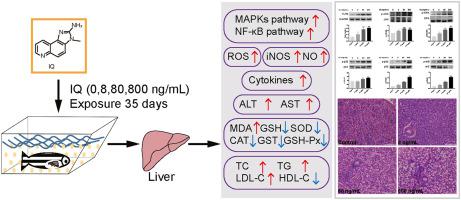Food and Chemical Toxicology ( IF 3.9 ) Pub Date : 2021-09-23 , DOI: 10.1016/j.fct.2021.112583 Dan Li 1 , Zhi Li 1 , Caiyi Qiu 1 , Bo Peng 1 , Yan Zhang 1 , Hongwen Sun 2 , Shuo Wang 1

|
2-Amino-3-methylimidazole[4,5-f]quinoline (IQ) is a harmful substance, mainly existing in protein-abundant thermally processed foods and polluted environments. This study investigated the hepatotoxicity of IQ by exposing zebrafish model organisms at 0, 8, 80, and 800 ng/mL concentrations for 35 days and was supposed to reveal the mechanism of IQ-induced oxidative stress and inflammation in the liver. The results showed that, after IQ exposure, alanine aminotransferase (ALT), aspartate aminotransferase (AST), reactive oxygen species (ROS), and malondialdehyde (MDA) levels in zebrafish liver increased significantly; meanwhile, significantly increased tumor necrosis factor-α (TNF-α), interleukin-1β (IL-1β), interleukin-6 (IL-6), and interleukin-12 (IL-12) levels induced severe oxidative stress and inflammation; however, glutathione (GSH), superoxide dismutase (SOD), catalase (CAT), glutathione s-transferase (GST) and glutathione peroxidase (GSH-Px) levels significantly decreased. The results indicated that the increased IQ exposure gradually aggravated pathological changes of zebrafish liver tissue (irregular cell morphology, cytoplasmic vacuolation, and inflammatory cell infiltration) and induced significant liver damage at last. Alterations in the expressions of genes and proteins involved in the IQ-induced TLR4/MAPK and TLR4/NF-κB pathways can elucidate the mechanism of its hepatotoxicity. The study provides evidence of IQ-induced hepatotoxicity and helps to draw attention to the health risks of dietary and environmental exposure to IQ.
中文翻译:

2-氨基-3-甲基咪唑并[4,5-f]喹啉通过 TLR4/MAPK 和 TLR4/NF-κB 信号通路在斑马鱼 (Danio rerio) 肝脏中诱导氧化应激和炎症
2-氨基-3-甲基咪唑[4,5-f]喹啉(IQ)是一种有害物质,主要存在于富含蛋白质的热加工食品和污染环境中。本研究通过在 0、8、80 和 800 ng/mL 浓度下暴露斑马鱼模型生物 35 天来研究 IQ 的肝毒性,并旨在揭示 IQ 诱导的肝脏氧化应激和炎症的机制。结果表明,IQ暴露后,斑马鱼肝脏中的丙氨酸氨基转移酶(ALT)、天冬氨酸氨基转移酶(AST)、活性氧(ROS)和丙二醛(MDA)水平显着升高;同时,显着增加的肿瘤坏死因子-α(TNF-α)、白细胞介素-1β(IL-1β)、白细胞介素6(IL-6)和白细胞介素12(IL-12)水平诱导严重的氧化应激和炎症;然而,谷胱甘肽(GSH),超氧化物歧化酶 (SOD)、过氧化氢酶 (CAT)、谷胱甘肽 s-转移酶 (GST) 和谷胱甘肽过氧化物酶 (GSH-Px) 水平显着下降。结果表明,IQ暴露逐渐加重斑马鱼肝组织的病理变化(细胞形态不规则、细胞质空泡化和炎性细胞浸润),最终导致明显的肝损伤。参与 IQ 诱导的 TLR4/MAPK 和 TLR4/NF-κB 通路的基因和蛋白质表达的改变可以阐明其肝毒性的机制。该研究提供了智商引起的肝毒性的证据,并有助于引起人们对饮食和环境暴露于智商的健康风险的关注。结果表明,IQ暴露逐渐加重斑马鱼肝组织的病理变化(细胞形态不规则、细胞质空泡化和炎性细胞浸润),最终导致明显的肝损伤。参与 IQ 诱导的 TLR4/MAPK 和 TLR4/NF-κB 通路的基因和蛋白质表达的改变可以阐明其肝毒性的机制。该研究提供了智商引起的肝毒性的证据,并有助于引起人们对饮食和环境暴露于智商的健康风险的关注。结果表明,IQ暴露逐渐加重斑马鱼肝组织的病理变化(细胞形态不规则、细胞质空泡化和炎性细胞浸润),最终导致明显的肝损伤。参与 IQ 诱导的 TLR4/MAPK 和 TLR4/NF-κB 通路的基因和蛋白质表达的改变可以阐明其肝毒性的机制。该研究提供了智商引起的肝毒性的证据,并有助于引起人们对饮食和环境暴露于智商的健康风险的关注。参与 IQ 诱导的 TLR4/MAPK 和 TLR4/NF-κB 通路的基因和蛋白质表达的改变可以阐明其肝毒性的机制。该研究提供了智商引起的肝毒性的证据,并有助于引起人们对饮食和环境暴露于智商的健康风险的关注。参与 IQ 诱导的 TLR4/MAPK 和 TLR4/NF-κB 通路的基因和蛋白质表达的改变可以阐明其肝毒性的机制。该研究提供了智商引起的肝毒性的证据,并有助于引起人们对饮食和环境暴露于智商的健康风险的关注。






























 京公网安备 11010802027423号
京公网安备 11010802027423号